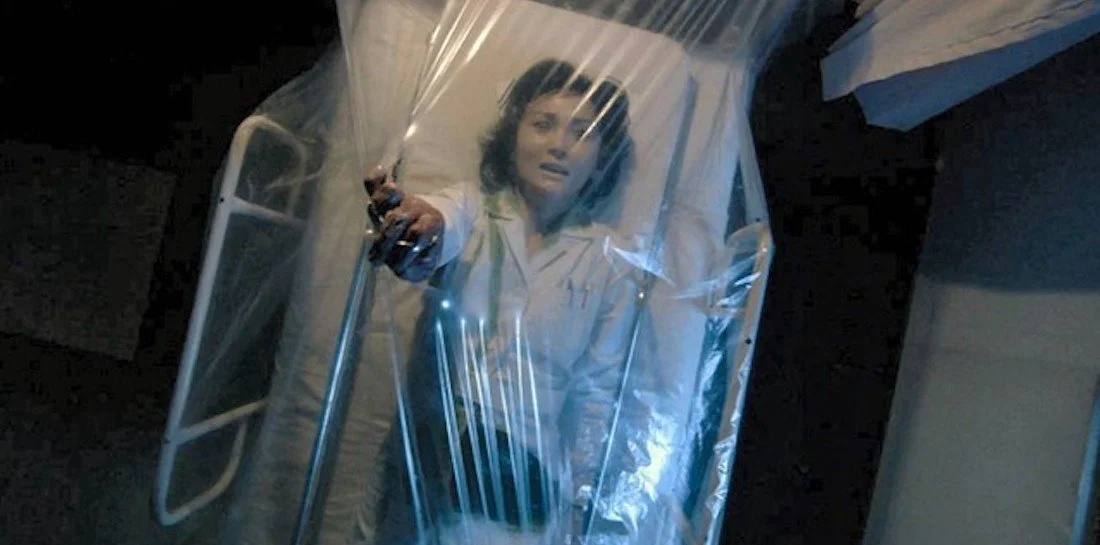INFECTION (2004)
I’ve had people ask me where I find movie recommendations and to be honest my answer is everywhere. I’ve written down titles from tons of list articles, found funky screenshots to reverse-image searched the film, and scoured through huge Twitter threads and Letterboxd lists. I keep everything in a huge note on my phone and have days where I pick a few at random to watch. I have a lot more winners than duds, honestly. One of those is INFECTION.
(Some spoilers below for an 18-year old film)
Written and directed Masayuki Ochiai—who is probably best known for the PARASITE EVE film (based on the book from which the video game is also adapted) and the American remake of SHUTTER—2004’s INFECTION is the first in a series of a six-film anthology titled “J-Horror Theater.” After the smash-hit RINGU, the genre was reignited with talent and creative storytellers. These films were:
This film, KANSEN (INFECTION)
YOGEN (PREMONITION) directed by Norio Tsuruta (RING 0 and KAKASHI)
RINNE (REINCARNATION) directed by Takashi Shimizu (Creator of JU-ON aka THE GRUDGE)
SAKEBI (RETRIBUTION) directed by Kiyoshi Kurosawa (CURE and PULSE, two of the best J-Horror of all time)
KAIDAN directed by Hideo Nakata (RINGU, DARK WATER, and THE COMPLEX)
KYŌFU (THE SYLVIAN EXPERIMENTS) directed by Hiroshi Takahashi (Writer on RINGU)
I wish they stuck with the naming convention of the first four, but it’s still a powerhouse of J-Horror and would be a good Introductory Course. For your first lesson, I suggest paying attention to the use of colour in J-Horror. This is especially important in today’s film.
INFECTION takes place in a run-down hospital, following several doctors and nurses going through a night shift. Something you’ll realize immediately is that all of these people are terrible. They’re negligent, lazy, and coldhearted in their treatment of patients…and each other.
In the first scene, an old man horrifically breaks his ankle because he needed to use the bathroom and no one could assist him. The nurse just shrugs in response. An ambulance radios the hospital to let them know of an incoming patient and they switch off the radio.
Another nurse practices her syringe skills on an unconscious patient, turning them into a pincushion. This introduction to the staff sets up the chaos well. Every little misstep like this adds to the stressful vibe the film gives off, like a pot ready to boil over.
Visually, it’s grimy. This is a hospital, a place we’d hope to be hygienic and sterilized but everything looks like it has a layer of grease slathered on top. This is exacerbated by a busted generator, so the heat is literally rising in the building, making everyone sweaty and uncomfortable. Part of this look is the quality and the film showing its age, but it’s also the use of off-greys, muddy browns, bright reds, and the iconic green, which I can only describe as a combination of Nickelodeon slime and FLUBBER. Reds are used for health and life, while green is disease and decay.
Things go from terrible to somehow even worse after the ambulance shows up with a new addition while simultaneously a severe burn patient goes into cardiac arrest. Dr. Akiba, who we’ve been following thus far, tries to turn away the newcomer rightfully flabbergasting the paramedic.
The entire team attempts to stabilize the burn victim but, after the wrong drug is administered, he dies.
This sets off a chain of events as, instead of dealing with the problem, the staff decides to destroy the body and hide any evidence of their wrongdoing.
Meanwhile, the recently admitted ambulance patient who was unceremoniously dumped on them is literally liquifying, leaving piles of nasty green goo all over the room. We don’t actually see the decay, instead, we get the entire hospital staff’s reaction as they try not to throw up.
“He smiled at me,” Dr. Akiba says. That’s horrifying and gives you just enough to fill in the rest of the disgusting details with your imagination.
This was made in 2004, so CGI wasn’t easy or affordable, especially for a small Japanese film. The gore effects in INFECTION are minimal and the focus is on how it affects the characters and their decisions throughout the night. Unfortunately, this is where the film drags a bit for some (and I felt it during a recent rewatch), so consider that a heads-up. Every character has a decent amount of time spent concluding their story and that does add up in pacing.
In addition to this, there’s a pretty huge plot twist that I don’t want to give away. The clues are there if you want to put it together—I’ll be reviewing this during tomorrow’s class. (Kidding, of course!) INFECTION isn’t perfect by any means, but the fact that it’s left a memorable impression on me for over ten years is saying something.





